Gregory L. Brown
From the Sea to the Edge of Technology
From navigating the open seas as a licensed marine engineer to pioneering modernization in defense, infrastructure, and automation, my journey has been defined by a passion for innovation, problem-solving, and engineering excellence. With expertise spanning mechanical and civil engineering, energy management, AI-driven automation, and strategic project execution, I bridge traditional engineering principles with cutting-edge technology to build the future—one project at a time.
A Little About Me
I am an executive leader focused on capital project execution, operational strategy, and financial stewardship, with a specialization in large-scale infrastructure, defense, and industrial modernization initiatives. As a dedicated Professional Engineer (PE) and Project Management Professional (PMP), I have a strong track record of leading diverse teams, managing significant capital investments, and driving operational efficiency through automation and digital transformation.
I prioritize pragmatic financial stewardship, ensuring that projects are executed in a cost-effective manner while managing P&L, capital expenditure (CAPEX) planning, and earned value management (EVM) for multi-million-dollar initiatives spanning defense, energy, and manufacturing sectors. I enjoy aligning business objectives with engineering innovation and leveraging Lean manufacturing, automation, and predictive analytics to enhance efficiency, resource allocation, and profitability.
I have had the opportunity to present technical briefings, financial justifications, and strategic roadmaps to high-ranking officials in the DoD, federal agencies, and C-level corporate leaders. My expertise includes risk management, regulatory compliance (MIL-STD, NAVSEA, API, ASME), and stakeholder engagement, all aimed at ensuring projects meet mission-critical objectives, adhere to industry standards, and achieve financial targets.
With a deep background in engineering management, EPC oversight, and advanced simulation modeling, I utilize tools like FlexSim Discrete Event Simulation (DES), digital twin technology, and 3D CAD solutions (such as SolidWorks, ANSYS, and Autodesk Revit) for high-precision design and operational optimization.
As a transformational leader, I combine engineering expertise with business strategy to secure multi-million-dollar contracts, optimize capital investments, and drive large-scale project success. I value collaboration and am committed to balancing technical excellence with a welcoming approach, ensuring data-driven decision-making results in positive outcomes for all stakeholders.
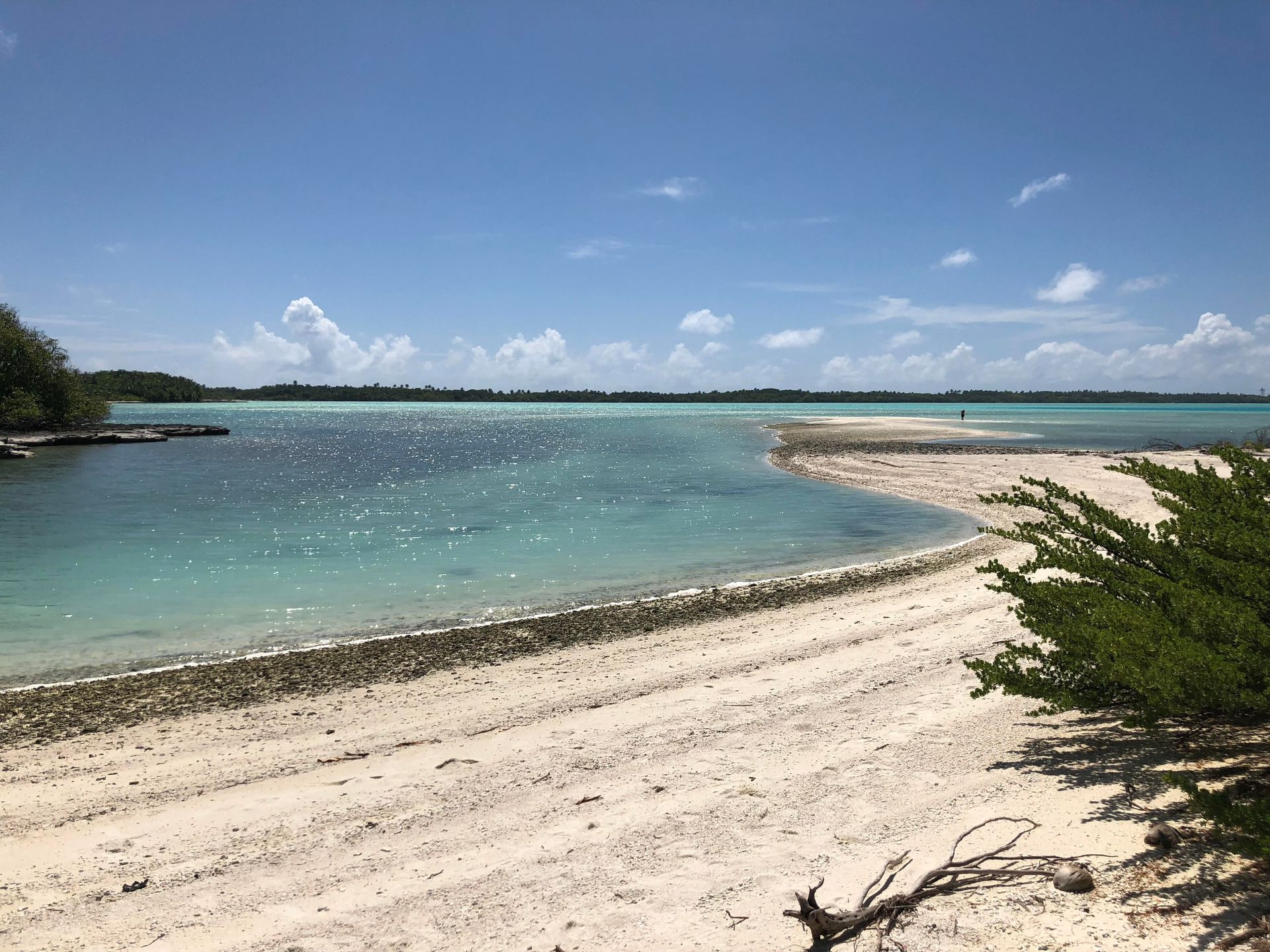
Turtle Cove - Diego Garcia - 2019
Formal Education
From engine rooms to boardrooms, from blueprints to business strategy—an education that bridges engineering precision with executive vision.
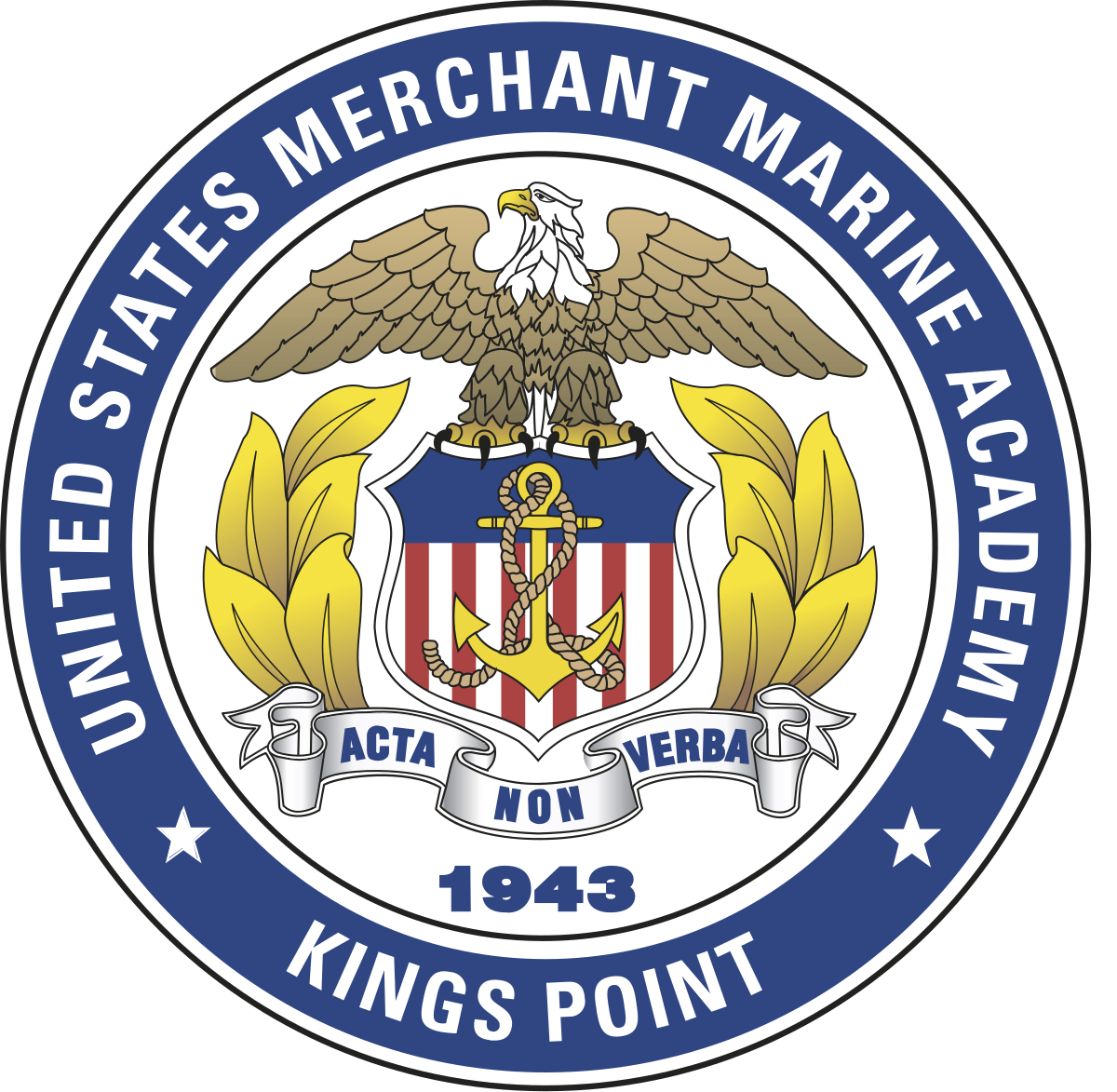
B.S. Marine Engineering

Masters of Business Administration
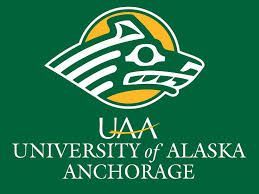
Graduate Studies - Coastal Engineering and Water Resources
Last Five Professional CE Courses Taken (as of 03/12/25)
- Improving Project Communication (ASCE - 12/24/24)
- Certified Energy Manager (AEE - 01/10/25)
- Humidity Control Design (ASHRAE - 12/10/24)
- Discrete Optimization (Coursera - 02/22/25)
- Data Extraction, Transformation, and Loading (ETL) - (Google - 02/28/25)
Past Employers
I am deeply grateful for the opportunities my past employers have given me to contribute, grow, and refine my expertise in engineering, modernization, and innovation. Their trust and mentorship have been invaluable in shaping my journey, reminding me that no one succeeds alone. I carry forward that generosity, striving to innovate, mentor, and give back in every endeavor. See links at right for a more detailed view.
Maritime
Full Steam Ahead
Faces of Humanity
My Tech Stack:
Programming & Scripting:
Python, SQL, Visual Basic (VB), JavaScript, MATLAB, MathCAD, HTML, CSS, R, TK Solver
Engineering & Simulation Software:
FlexSim (DES), Autodesk Revit, AutoCAD, SolidWorks, ANSYS (FEA), STAAD (Structural), Bluebeam, HVAC Solution, Trane TRACE 3D
Data & Business Intelligence:
Microsoft Power BI, SQL Server, Google Cloud Platform (GCP), Google BigQuery, ESRI ArcGIS (GIS & Spatial Analysis)
Certified Scrum Master (CSM)
Project & Workflow Tools:
Microsoft Project, Office Suite (Excel, Word, PowerPoint, Outlook, Teams, OneNote), Procore
Automation & Process Optimization:
API Integration, Machine Learning (ML) for Predictive Analytics, Industry 4.0, CAD/BIM Automation, Digital Twin Development
Cybersecurity & Compliance:
CMMC, FAR & DFARS (Federal Contracting Compliance)
Software Development & Version Control:
Git, GitHub, Jira, DevOps, CI/CD Pipelines
Work Experience
Marine Engineering Experience
Starting my career as a U.S. Coast Guard-licensed Third Assistant Engineer (Unlimited Horsepower), I quickly learned that working through the engineering ranks aboard RO-RO vessels, Maritime Prepositioning Ships (MPS), and tankers was both a technical challenge and a test of resilience. The journey from an entry-level engineer to a leadership position in shipboard engineering required a deep understanding of marine propulsion systems, a commitment to safety, and the ability to lead under pressure.
Shipboard Engineering Operations: Mastering Complex Systems
Working on high-pressure steam plants, slow and medium-speed diesel engines, and integrated power generation systems, I was responsible for optimizing performance and ensuring system reliability. This included supervising boiler operations, fuel purification, and turbine maintenance—each a critical component in maintaining a vessel’s efficiency and seaworthiness.
Machinery Maintenance & Repair: Learning from Every Challenge
Shipboard maintenance is a 24/7 responsibility—there is no room for delays when navigating the open seas. I handled preventive and corrective maintenance on key systems, including refrigeration, HVAC, freshwater generation, hydraulic, and pneumatic systems. Major overhauls, such as main engine repairs, bearing replacements, and pressure vessel inspections, had to be executed flawlessly, often under intense time constraints.
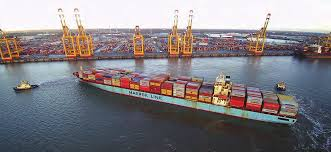
Tanker & Cargo System Operations: Balancing Safety & Efficiency
Shipboard maintenance is a 24/7 responsibility—there is no room for delays when navigating the open seas. I handled preventive and corrective maintenance on key systems, including refrigeration, HVAC, freshwater generation, hydraulic, and pneumatic systems. Major overhauls, such as main engine repairs, bearing replacements, and pressure vessel inspections, had to be executed flawlessly, often under intense time constraints.

Serving aboard tankers, I oversaw pump room operations, ballast systems, and inert gas systems (IGS), ensuring compliance with OCIMF, MARPOL, and USCG pollution prevention regulations. Managing liquid cargo transfers required precision, as stability and flow rates had a direct impact on operational efficiency.
Automation & Control Systems: The Shift to Digitalization
Shipboard maintenance is a 24/7 responsibility—there is no room for delays when navigating the open seas. I handled preventive and corrective maintenance on key systems, including refrigeration, HVAC, freshwater generation, hydraulic, and pneumatic systems. Major overhauls, such as main engine repairs, bearing replacements, and pressure vessel inspections, had to be executed flawlessly, often under intense time constraints.
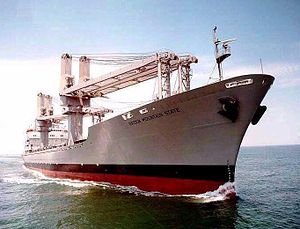
With marine engineering evolving rapidly, PLC-based engine controls, power distribution systems, and automated monitoring technologies became integral to operations.
Emergency Response & Compliance: Engineering Under Pressure
As Engineering Officer of the Watch (EOOW), I managed machinery failures, fire alarms, and emergency drills—all while ensuring adherence to the ISM Code, SOLAS regulations, and vessel-specific Safety Management Systems (SMS).
Typical Vessel Discharge - This one for the M/V Patriot shown in the second image above.
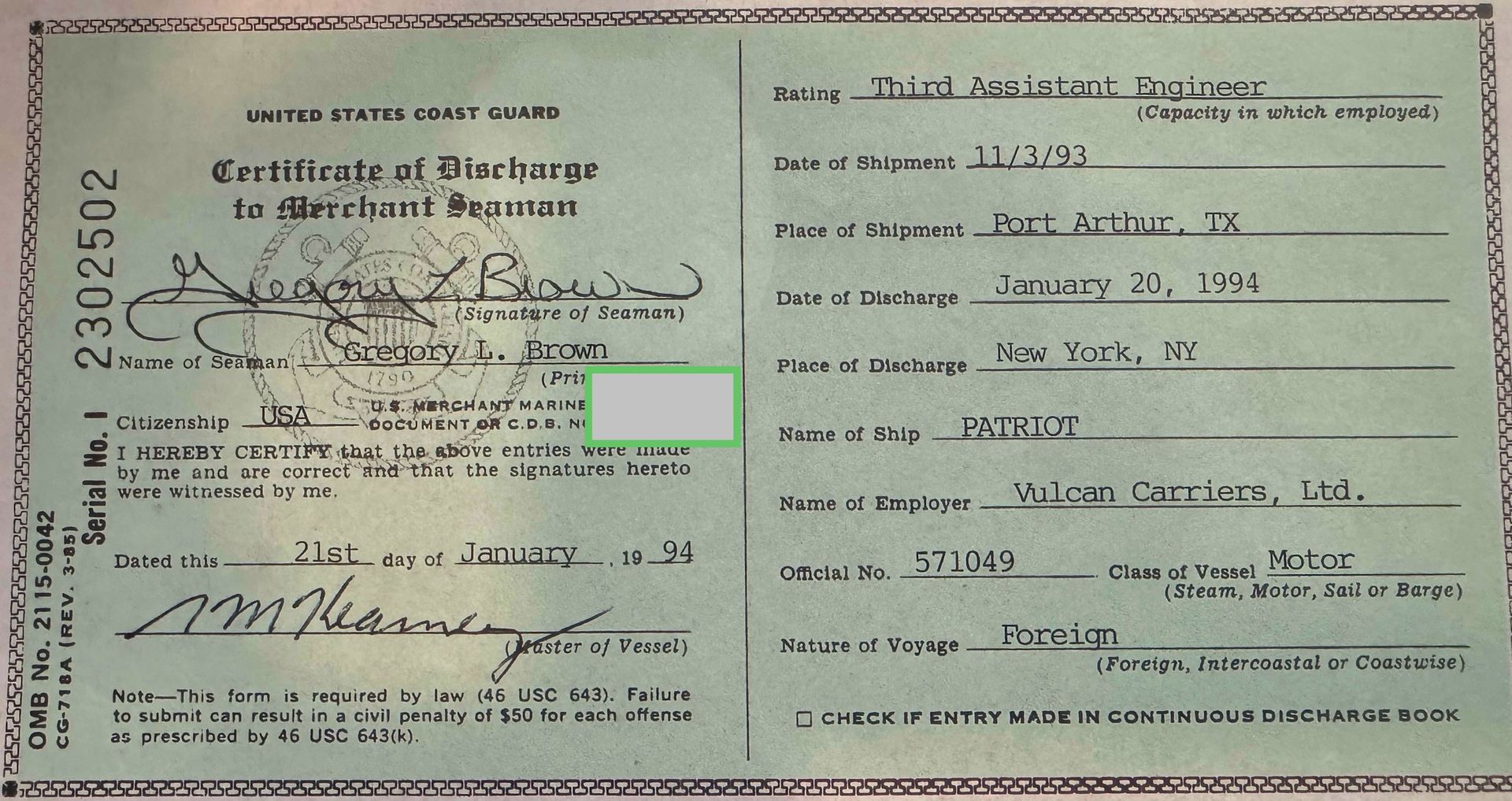
Typical Vessel Discharge - This one for the SS Green Mountain State shown in the third image above.

First Engineer of Steam and Diesel Vessels of any Horsepower -1996
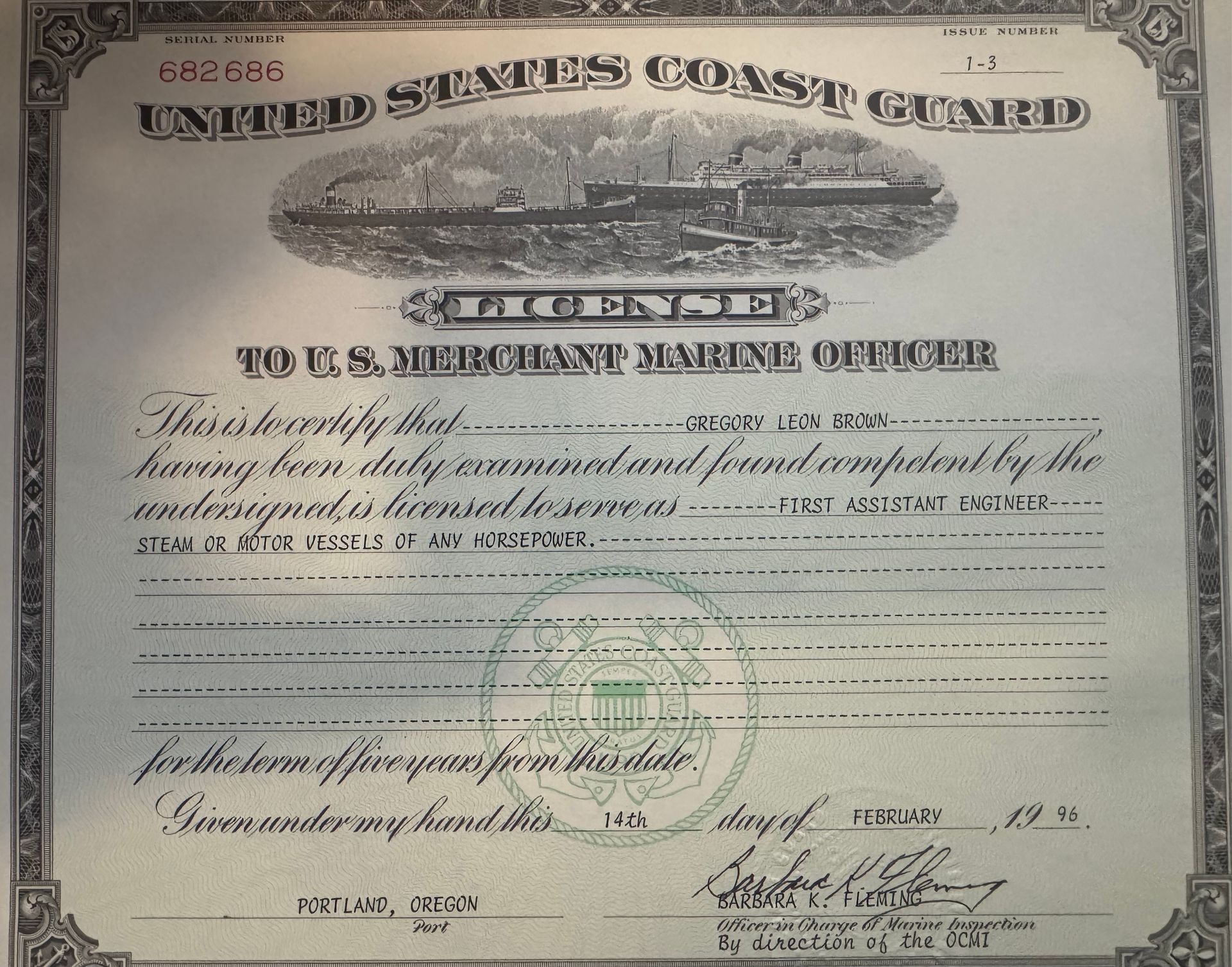
Project Engineer – Defense Manufacturing & Naval Systems Development
As a Project Engineer in a defense manufacturing company, I played a pivotal role in the design, production, testing, and deployment of mission-critical naval systems for the U.S. Navy and Marine Corps. My responsibilities spanned precision engineering, compliance with military standards, and ensuring the delivery of fully tested and operational equipment for programs such as the LPD-17 San Antonio-Class Amphibious Transport Dock and the Advanced Seal Delivery System (ASDS).
Advanced Seal Delivery System (ASDS) – Supporting Special Operations
The ASDS, a mini-submarine used for covert special operations, required precision machining, subsea system integration, and corrosion-resistant materials to withstand harsh maritime environments. I provided engineering and manufacturing support, ensuring all components met NAVSEA and SOCOM requirements for secrecy, durability, and operational effectiveness.
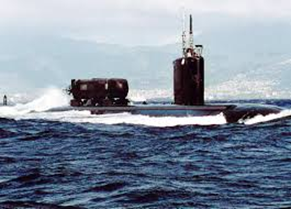
LPD-17 San Antonio-Class Amphibious Transport Dock – Weapons & Cargo Handling Systems
For the LPD-17 program, I was responsible for designing and testing shipboard cargo elevators, weapons handling systems, and vertical replenishment equipment. These systems required rigorous validation for shock, vibration, and electromagnetic interference (EMI) resistance, ensuring seamless integration with the vessel’s combat and logistics infrastructure.
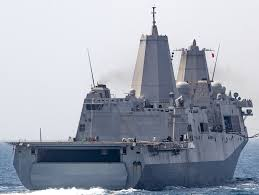
Testing & Field Deployment – Delivering Battle-Ready Systems
No system was considered mission-ready without rigorous validation. I conducted functional testing, load simulations, and factory acceptance tests (FATs) to verify performance before deployment. I also oversaw installation and final integration aboard naval vessels, ensuring seamless operation in combat and expeditionary environments.
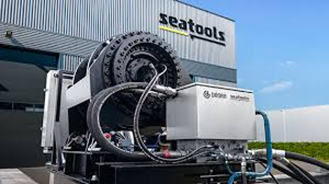
Delivering Tested & Operational Defense Solutions
As a Project Engineer, I contributed to the successful deployment of combat-ready naval systems, ensuring the U.S. Navy and Marine Corps received high-performance, fully tested solutions that enhanced mission capability, survivability, and operational effectiveness. My expertise in defense manufacturing, compliance, and system testing was critical in equipping modern naval forces with cutting-edge engineering solutions. ** In 2006, Unidynamics was sold to PAR Systems, a link to which is in the above prior company icons.
Applications Engineer specializing in CAD and FEA software
In the late 1990s, a SolidWorks Software Applications Engineer played a crucial role in the adoption and implementation of 3D CAD software solutions across various industries, including oil & gas, aerospace, and manufacturing. Their responsibilities combined technical expertise, customer support, software training, and workflow automation to enhance engineering design efficiency.
1. Software Sales & Pre-Sales Engineering
Assisted clients in selecting the right SolidWorks 3D CAD, COSMOS FEA, and Working Model kinematic analysis software for their engineering needs. Conducted live demonstrations, ROI analyses, and proof-of-concept implementations for major industry clients like Halliburton, Oceaneering, Kvaerner, National Oilwell, and Oil States Industries. Worked closely with sales teams to drive software adoption, ensuring clients understood the value of 3D CAD and simulation technologies in improving design workflows.
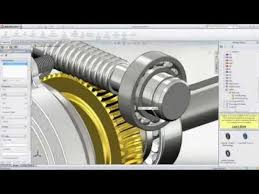
2. Enterprise-Level Technical Support & Troubleshooting
Served as the primary technical resource for customers, providing expert troubleshooting, installation assistance, and software performance optimization. Diagnosed complex system issues related to software functionality, compatibility, and performance, ensuring compliance with industry standards and engineering workflows. Assisted engineering teams in resolving CAD-related issues, improving design accuracy and efficiency.
3. Custom Software Development & Automation
Developed Visual Basic (VBA) macros and API integrations to automate SolidWorks modeling, Bill of Materials (BOM) generation, and engineering workflows. Created custom CAD templates, scripting solutions, and database-driven tools to improve efficiency and seamless integration with PDM/PLM systems. Provided specialized automation for companies like Kvaerner and Oceaneering, reducing manual design errors and increasing productivity.
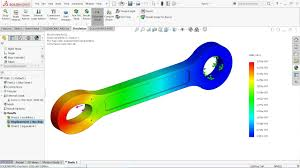
4. Customer Training & Implementation
Led on-site and virtual training sessions covering essential SolidWorks skills, including parametric modeling, advanced assemblies, stress analysis, and motion simulation. Developed customized training programs and documentation for large clients such as Halliburton, National Oilwell, and Oil States Industries, ensuring that engineers fully leveraged SolidWorks and simulation tools for improved design validation. Provided ongoing support and best practices to optimize CAD utilization, accelerating adoption in engineering and manufacturing workflows.
Impact of the Role
A SolidWorks Applications Engineer in 1998-1999 played a key role in driving CAD adoption, optimizing design efficiency, and integrating automation tools for engineering teams. Their expertise in technical support, training, and workflow automation helped bridge the gap between traditional 2D drafting and the emerging world of 3D parametric modeling, enabling companies to improve product development speed, accuracy, and overall engineering performance. Over this timeframe, I had trained over 238 engineers in SolidWorks for companies like Kvaerner, Halliburton, and Baker Hughes.

Certified SolidWorks Instructor

Certified SolidWorks Technician
Consulting Engineer – Subsea MudLift Drilling System Development
As a Consulting Engineer for a Joint Industry Project (JIP), I contributed to the development of an innovative Subsea MudLift Drilling System in collaboration with Hydril, Shell, BP, and Chevron. The project enhanced deepwater drilling by integrating high-pressure, high-temperature (HPHT) technologies and real-time system monitoring.
Deepwater Equipment Design & Compliance
At Hydril, I was part of a team that designed subsea wellhead systems, BOPs, and riser components for ultra-deepwater drilling. We ensured compliance with API 6A, API 16A, API 17D, B31.3, etc ASME BPVC, focusing on pressure containment, fatigue resistance, and material longevity in HPHT environments. Using FEA, hydrostatic testing, fatigue analysis, and digital twin modeling, we optimized structural integrity and reliability. Our team developed and tested high-pressure sealing systems, conducting hydrogen embrittlement and HPGD testing to validate metallurgical integrity and long-term sealing performance. I contributed to design verification, full-scale fatigue analysis, and installation coordination, working with rig operators and subsea teams to ensure seamless integration. These efforts ensured that critical subsea components met stringent safety and performance requirements for ultra-deepwater drilling operations. Deployment on the Pacific Santa Ana shown at right.

3D CAD & Digital Twin Simulation
Developed 3D models and digital twins in SolidWorks and AutoCAD to simulate mechanical performance, stress distribution, and fluid flow. Integrated National Instruments’ Lookout SCADA software for real-time monitoring, reducing failure risks.
Finite Element Analysis (FEA) & Structural Optimization
Conducted stress, fatigue, and transient thermal simulations using ANSYS, Abaqus, and LS-DYNA to optimize drilling performance. Modeled interactions between riser systems, mud pumps, and BOP stacks to enhance deepwater reliability.
Material Testing & Qualification
Led hydrogen embrittlement, stress corrosion cracking (SCC), and high-pressure gas decompression (HPGD) testing for corrosion-resistant superalloys and elastomers. Evaluated coatings and material treatments to extend service life in subsea environments.
Impact of the Project
Participating in the Subsea MudLift Drilling (SMD) Joint Industry Project (JIP), I contributed to the development of a cost-effective mudlift drilling system through engineering design, simulation, and materials testing. This initiative significantly enhanced deepwater drilling safety, efficiency, and equipment lifespan for major operators like Shell, BP, and Chevron. The SMD JIP successfully field-tested a prototype subsea mud lift pump, demonstrating the viability of dual-gradient drilling technology in the Gulf of Mexico. This advancement addressed challenges associated with narrow pressure margins in deepwater drilling, reducing the risk of wellbore instability and enabling more efficient drilling operations.
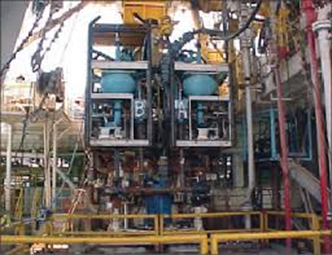
Project Reference
Engineer II – Subsea Sealing System Development
As an Engineer II within Greene Tweed’s SealConnect Group, I specialized in designing and optimizing high-performance polymer and elastomeric sealing solutions for subsea oil and gas connectors. This role required expertise in materials science, finite element analysis (FEA), and advanced manufacturing techniques to develop HPHT-resistant seals and gaskets that met offshore drilling and production standards.
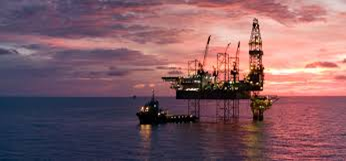
Subsea Connector & Sealing System Design
- Engineered high-performance elastomeric and thermoplastic seals for subsea wellheads, blowout preventers (BOPs), and riser systems.
- Ensured compliance with API 6A, API 17D, and NORSOK standards, optimizing sealing integrity for HPHT environments.
- Specialized in rubber compounding, thermoplastic elastomers (TPE), and perfluoroelastomer (FFKM) materials, enhancing resistance to extreme pressures, aggressive fluids, and thermal cycling.
Finite Element Analysis (FEA) & Mechanical Simulation
- Performed non-linear stress analysis, snap-through simulations, and transient thermal modeling using ANSYS, Abaqus, and MoldFlow.
- Optimized polymer-metal bonding applications, ensuring long-term reliability in subsea environments.
- Developed simulation-driven failure prevention strategies, extending seal service life under dynamic loading conditions.
Manufacturing Process Optimization
- Led improvements in rubber molding, extrusion, and injection molding processes, reducing material waste and production cycle times.
- Applied Lean Manufacturing and Six Sigma methodologies to enhance compounding, curing, and bonding processes.
- Ensured ISO 9001 and AS9100 compliance, improving quality control and repeatability in high-volume manufacturing.
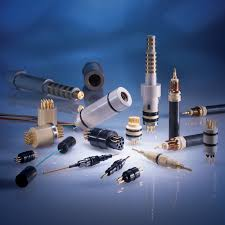
Impact & Engineering Innovation
Through advanced FEA modeling, materials science, and process optimization, I contributed to next-generation subsea sealing solutions that improved reliability, chemical resistance, and operational longevity in ultra-deepwater applications. My work helped oil and gas operators reduce downtime, enhance equipment performance, and meet evolving industry standards for extreme offshore environments.
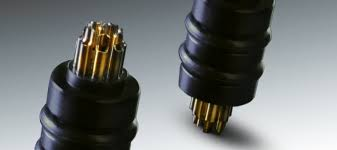
Project Design Engineer – Offshore Equipment & Pipeline Systems
As a Project Design Engineer, I specialized in designing, manufacturing, and deploying pig launchers, HPHT equipment, and pipeline safety systems for offshore operations. Supporting clients like BP, Shell, and Wood Group, my role involved advanced CAD modeling, FEA, pipe stress analysis, ERP integration, and offshore support to ensure safe and efficient equipment performance in extreme environments.
Key Responsibilities & Contributions
- Designed pig launchers, receivers, and HPHT wellhead equipment for offshore pipeline maintenance and production.
- Conducted FEA using ANSYS to optimize structural integrity, thermal performance, and fatigue resistance.
- Performed pipe stress analysis (CAESAR II) to ensure offshore pipeline systems met API 6A, API 17D, and ASME B31.3/B31.8/Div.1&2 standards.
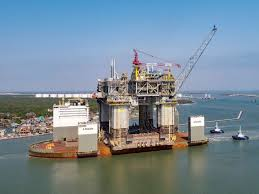
BP Mad Dog Offshore Platform
Offshore Customer Support & Field Engineering
- Provided real-time engineering support for offshore installations, troubleshooting pigging system failures and pressure control issues.
- Conducted safety inspections and operational assessments, ensuring integration of equipment with offshore infrastructure.
- Worked with BP, Shell, and Wood Group’s field engineers, adapting designs for harsh offshore conditions.
Design for Safety & Compliance
- Developed fail-safe pressure containment solutions, ensuring compliance with API 6A, API 17D, ASME BPVC, and ISO 9000 standards.
- Designed quick-access enclosures and emergency shutdown features for pigging operations, enhancing safety and reliability.
- Integrated corrosion-resistant materials and coatings to extend equipment lifespan in offshore environments.
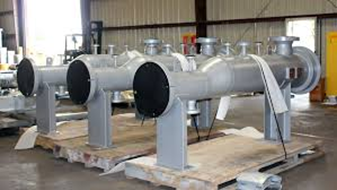
LTS Energy Equipment - Design & Manufacturing
ERP & Digital Process Automation
- Developed CAD-to-ERP bridges to automate BOM transfers, inventory tracking, and procurement workflows.
- Integrated VBA, JavaScript, and SQL databases to streamline design-to-production efficiency.
- Built real-time dashboards for cost tracking, production scheduling, and offshore quoting models.
🔗 Watch Project Overview Video
Impact & Industry Contributions
By integrating FEA, pipe stress analysis, and digital automation, I helped deliver high-performance, safety-compliant pigging systems and HPHT equipment. My work enabled offshore operators to maintain pipeline integrity, improve flow assurance, and enhance operational safety, making deepwater and high-pressure projects more efficient and reliable.
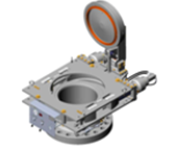
LTS Energy - Closure Initial Development
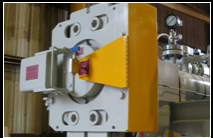
LTS Energy - Closure Built
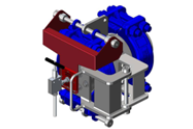
LTS Energy - Closure Initial Development
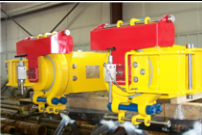
LTS Energy - Closure Built
Senior Mechanical Engineer – Defense & Federal Projects
As a Senior Mechanical Engineer at San Juan Construction, I provided mechanical engineering leadership for highly technical and logistically complex defense projects under NAVFAC, USACE, and USAF contracts. My work spanned Kwajalein Atoll, Hawaii, and Diego Garcia .
Project-Specific Experience & Notable Installations
Vehicle Paint & Prep Facility – Kwajalein Atoll, Marshall Islands
- Designed and installed ventilation, air filtration, and climate control
for a high-performance vehicle painting facility.
- Ensured compliance with airborne contaminant regulations, fire suppression, and safety protocols
in a tropical, high-humidity environment.

Mirror Coating Facility – Hawaii - DoD’s Largest Telescope
- Engineered precision HVAC, humidity control, and cleanroom systems
for high-accuracy optical coatings.
- Designed dust-free air handling systems and temperature-stable environments
to support defect-free coatings.



Bachelor Quarters (BQs) – Diego Garcia
- Led mechanical system design and installation
for multiple BQ housing facilities.
- Designed energy-efficient climate control systems
for tropical conditions while meeting DoD standards
.

Impact & Engineering Contributions
Through mechanical engineering leadership, strategic problem-solving, and cross-disciplinary collaboration , I played a critical role in delivering mission-ready, high-security military infrastructure .
Owner and Consultant - BST, LLC
TL;DR: Owned and operated an engineering consulting firm.
From 2007 to 2011, I owned and operated an engineering consultancy, providing expert-level engineering, project management, and technical analysis for clients in heavy-duty manufacturing, offshore oil & gas, and complex mechanical systems integration. Serving major clients like LTS Energy, BP, Shell, Wood Group, and Transocean, I was responsible for everything from high-pressure system design and FEA simulations to procurement, logistics, and ERP implementation.
However, running a small engineering consultancy wasn’t just about delivering technical excellence—it also came with the challenges of business development, financial management, and sustaining growth in a highly competitive industry.

Core Responsibilities & Contributions
- Advanced Engineering & Systems Integration
- Designed high-pressure flanges, clamp/hub assemblies, and custom components.
- Conducted FEA analysis using ANSYS, TK Solver, STAAD for offshore structures.
- Produced comprehensive design reports meeting ABS, DNV, and CRN evaluation standards.
- Supported 4- and 5-axis CNC programming, optimizing G-Code in MasterCam.
- Business Operations & Client Management
- Managed procurement, scheduling, materials management, and quality control.
- Provided logistics support for offshore and onshore projects.
- Led negotiations with suppliers and clients to balance cost and technical feasibility.
- Built long-term relationships with energy and industrial firms.
- Digital Transformation & ERP System Implementation
- Integrated Global Shop Solutions ERP, including database administration.
- Developed custom ERP automation solutions to streamline procurement and reporting.
Challenges of Running a Small Engineering Consultancy
Starting and running an engineering consultancy came with numerous challenges:
- Business Development & Client Acquisition: Finding clients and proving expertise.
- Financial Management & Cash Flow: Managing payroll and expenses while waiting for payments.
- Scaling & Resource Management: Hiring and subcontracting in a fluctuating market.
- Technical Excellence & Compliance: Staying updated with regulatory changes and certifications.

Scaling & Resource Management
Expanding the business meant balancing workload capacity, hiring engineers, and maintaining subcontractor relationships.
Finding qualified subcontractors for FEA, CAD modeling, and ERP integration required a strong professional network.

Impact & Lessons Learned
Running an engineering consultancy provided an invaluable blend of **technical, business, and leadership experience.**
I gained firsthand insight into entrepreneurship, financial management, and digital transformation.
Despite challenges, the ability to deliver expert-level engineering solutions while managing a business was incredibly rewarding.

Critical Decision Making in Business
Running a Small Business - A Humorous Look
What it's like running a small business in engineering:
Trying to manage clients, payroll, and engineering projects... all at once! 🤯😂
Engineering & QC Manager - San Juan Construction
TL;DR: Engineering and Quality Control Manager for large-scale federal projects.
As an Engineering & Quality Control (QC) Manager at San Juan Construction, I was responsible for quality assurance, engineering coordination, and regulatory compliance for $276M+ in federal construction projects under the U.S. Army Corps of Engineers (USACE) and Naval Facilities Engineering Systems Command (NAVFAC) contracts.
My role required ensuring full compliance with USACE CQM-C, NAVFAC UFGS, and Federal Acquisition Regulations (FAR) while managing the engineering, execution, and validation of high-security military infrastructure in remote and logistically challenging environments.

Key Responsibilities & Contributions
- USACE & NAVFAC Quality Compliance Leadership
- Led quality control operations for federal defense projects.
- Implemented the Three-Phase QC system(Preparatory, Initial, and Follow-Up Inspections).
- Tracked non-conformance issues and enforced resolution.
- Construction Oversight & Deficiency Mitigation
- Supervised on-site testing, inspections, and documentation.
- Reduced rework and prevented schedule delays due to compliance failures.
- Developed corrective action plans (CAPs) to address non-conformance.
- Engineering Management & Multi-Disciplinary Coordination
- Directed engineering oversight for complex defense projects.
- Managed BIM workflows, reducing design approval timelines by 22%.
- Led multiple architectural and engineering (A/E) firms to execute projects seamlessly.
- Government Liaison & Compliance Reporting
- Served as the primary interface with USACE & NAVFAC Contracting Officers.
- Maintained Deficiency Tracking Logs (DTLs), QC Reports, and Submittal Registers.
- Coordinated design modifications and contract compliance.
High-Value Federal Defense Projects
$36M LEED Silver Water Treatment Plant – Diego Garcia:
- Directed design, construction, and commissioning of the LEED Silver-certified plant.
- Optimized efficiency and resilience of potable water reliability.
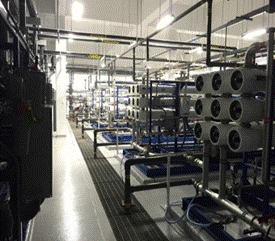
$32M High-Security Warehouse – Kwajalein Army Airfield:
- Led engineering oversight and design coordination for a high-security warehouse.
- Managed BIM integration and site logistics in remote locations.

Safety & Environmental Compliance
- Developed and enforced EM 385-1-1 safety plans.
- Oversaw high-risk construction activities to maintain regulatory compliance.
Supply Chain Optimization & EPC Efficiency
- Streamlined engineering, procurement, and construction (EPC) workflows.
- Negotiated supplier agreements to reduce costs and improve lead times.
Impact & Contributions
As an Engineering & QC Manager, I played a key role in delivering secure, high-performance military infrastructure.
My leadership ensured the successful completion of mission-critical projects, enhancing operational readiness.

Senior Engineer - Chenega Worldwide Support
TL;DR: Senior Engineer at Chenega Worldwide Support.
As a Mechanical & Civil Engineer at Chenega Worldwide Support, I provided engineering solutions for federal and defense projects worldwide, supporting USACE, USAF, and DOS/OBO operations.
My role focused on secure facility design, advanced technology integration, quality control, and compliance with cybersecurity and infrastructure security standards. I was responsible for optimizing mechanical, structural, and industrial systems for hardened and mission-critical facilities, ensuring their resilience, operational efficiency, and adherence to federal engineering requirements.
Key Responsibilities & Contributions
- Engineering Support for Federal & Defense Projects
- Delivered mechanical and civil engineering solutions for secure government facilities, industrial infrastructure, and mission-critical support systems.
- Ensured compliance with UFC, UFGS, ASHRAE, NFPA, and IBC standards, improving facility safety and performance.
- Provided structural and mechanical engineering assessments for overseas military installations, embassies, and secure operational facilities.
- Advanced Technology Integration (ATL) & Digital Engineering
- Spearheaded Building Information Modeling (BIM), CAD automation, and data-driven design strategies to improve engineering accuracy and efficiency.
- Utilized Autodesk Revit, Trane Trace 3D Plus,
and HVAC Solution
to:
- Optimize mechanical performance and HVAC efficiency.
- Reduce design cycle times and increase constructability.
- Improve coordination between multidisciplinary engineering teams.
- Led digital transformation efforts, integrating 3D modeling/BIM into federal engineering projects.
- Quality Control & Technical Compliance
- Conducted Independent Technical Reviews (ITRs) to validate structural integrity, blast resistance, and energy efficiency for hardened facilities.
- Managed QA/QC protocols to ensure compliance with USACE, USAF, and DOS/OBO construction standards, minimizing compliance risks, rework, and RFIs.
- Developed risk mitigation strategies and conducted real-time design validation to prevent construction errors and security vulnerabilities.
- Cybersecurity & Secure Infrastructure Compliance
- Provided engineering support for Sensitive Compartmented Information Facilities (SCIFs) and mission-critical government buildings.
- Ensured adherence to:
- ICD 705(Intelligence Community Directive for SCIFs).
- TEMPEST(Electromagnetic security and shielding standards).
- Hardened facility security guidelines to protect against blast threats and unauthorized access.
- Designed and reviewed secure mechanical and electrical systems for classified operational environments, ensuring resilience under threat conditions.
Impact & Engineering Contributions
As a Mechanical & Civil Engineer at Chenega Worldwide Support, I played a critical role in:
- Enhancing the security, durability, and operational efficiency of federal and defense infrastructure worldwide.
- Implementing digital engineering solutions to improve design accuracy, coordination, and constructability.
- Ensuring compliance with cybersecurity, blast resistance, and structural hardening standards for high-security government projects.
This role reinforced my expertise in secure facility engineering, advanced digital modeling, and federal infrastructure resilience, making critical contributions to national security and mission-critical operations.
Due to the nature of secure government projects, no images are available for display.
Assistant Division Engineer - State of Colorado
TL;DR: Assistant Division Engineer managing water rights and infrastructure.
As an Assistant Division Engineer for the Colorado Department of Water Resources, I managed water rights administration, oversaw regulatory compliance, and ensured equitable water distribution across the division. This position required expertise in hydrology, hydraulic modeling, legal frameworks, and resource management, balancing technical analysis with field operations and stakeholder coordination.


Key Responsibilities & Duties
- Water Rights Administration & Regulatory Compliance
- Enforce Colorado water laws, interstate compacts, and constitutional obligations to ensure fair and legal water distribution.
- Review and interpret water rights decrees, augmentation plans, and change applications to determine proper allocation of resources.
- Maintain accurate water accounting records, monitoring stream flows, reservoir releases, and groundwater pumping.
- Hydrologic & Hydraulic Analysis
- Utilize hydrologic models, GIS mapping, and real-time data monitoring to assess water availability and distribution trends.
- Conduct hydraulic modeling and streamflow forecasting, ensuring compliance with interstate compact agreements and environmental requirements.
- Analyze drought conditions, climate impacts, and seasonal flow patterns, making recommendations for adaptive water management strategies.
- Field Operations & Infrastructure Oversight
- Inspect dams, reservoirs, diversion structures, and irrigation systems to verify compliance with state engineering standards.
- Supervise the installation and calibration of flow measurement devices, ensuring accurate water use reporting.
- Coordinate with water commissioners and local stakeholders to resolve disputes and optimize water delivery efficiency.
- Water Court Case Review & Technical Evaluations
- Conduct technical reviews of water court applications, analyzing historical water use, return flow patterns, and consumptive use calculations.
- Provide expert recommendations on legal water right claims, ensuring compatibility with existing allocation frameworks.
- Collaborate with attorneys, engineers, and policy makers to develop data-driven litigation strategies and negotiate settlements on contested water rights issues.
- Stakeholder Coordination & Public Outreach
- Work with agricultural users, municipalities, and industrial water right holders to address water allocation disputes and compliance issues.
- Participate in public meetings, water roundtables, and inter-agency collaborations to promote sustainable water management practices.
- Assist in educating water users on regulatory changes, conservation strategies, and technical requirements for water rights administration.
- Budget & Financial Oversight
- Manage division expenditures, ensuring fiscal responsibility in infrastructure maintenance, monitoring programs, and regulatory enforcement.
- Optimize resource allocation by analyzing budget constraints and funding availability for key water resource initiatives.
- Utilize automated reporting tools to track spending trends and improve financial forecasting for long-term water management projects.
Impact & Contribution
The Assistant Division Engineer plays a crucial role in ensuring sustainable water resource management in Colorado, balancing legal mandates, hydrologic realities, and stakeholder needs. This position requires a strong technical foundation in hydrology and engineering, combined with regulatory expertise and field operations oversight, to protect Colorado’s water future while maintaining fair and efficient resource distribution.

Morrow Point Dam, Colorado 2021
Senior Project Manager - Mason & Hanger
As a Senior Project Manager at Mason & Hanger, responsibilities focus on leading federal and defense infrastructure projects, ensuring technical execution, regulatory compliance, and project efficiency. The role requires coordination across engineering, procurement, construction, and government agencies to deliver mission-critical facilities on time and within budget.

Inert M795 Artillery Prep
Key Responsibilities
- Project Planning & Execution
- Develop and oversee project schedules, budgets, and work breakdown structures (WBS).
- Implement Earned Value Management (EVM) and forecasting to track costs, progress, and performance metrics.
- Coordinate with engineering teams to ensure design feasibility, constructability, and compliance with federal standards.
- Stakeholder & Client Engagement
- Serve as the primary point of contact for government clients, contractors, and subcontractors.
- Conduct project meetings, progress briefings, and risk management discussions with federal agencies.
- Manage contract requirements, ensuring compliance with DoD, DOE, USACE, and NAVFAC guidelines.
- Risk Management & Compliance
- Identify and mitigate project risks, cost overruns, and schedule delays.
- Ensure adherence to safety, security, and quality assurance standards, including USACE QC protocols, FAR/DFARS, and cybersecurity requirements.
- Oversee regulatory documentation, change orders, and compliance reporting.
- Construction & Engineering Oversight
- Collaborate with architects, engineers, and construction managers to resolve technical challenges.
- Conduct site visits and inspections to monitor construction progress, safety adherence, and QA/QC compliance.
- Oversee subcontractor performance, managing supply chain logistics and procurement strategies.
- Reporting & Strategic Planning
- Develop status reports, financial updates, and performance assessments for leadership and government stakeholders.
- Analyze lessons learned and continuous improvement initiatives to enhance future project delivery and execution.
- Align organizational goals with federal contracting strategies, supporting business development and growth opportunities.
Summary
As a Senior Project Manager at Mason & Hanger I played a critical role in managing federal and defense projects, balancing engineering oversight, contract compliance, and risk mitigation. This position ensures the successful execution of high-stakes government infrastructure projects, aligning with mission requirements and national security objectives.

M795 Firing for Effect
Vice President of Modernization - Mason & Hanger
TL;DR: Vice President of Modernization, overseeing strategic growth.
As the Vice President of Modernization at Mason & Hanger, responsibilities extend beyond project execution to strategic leadership, business development, and operational oversight. This role involves building and leading high-performing teams, driving market expansion, ensuring financial performance, and aligning engineering solutions with federal modernization initiatives.

Bradley Tank Body
Key Responsibilities
- Strategic Leadership & Business Growth
- Define and implement corporate strategies for modernization programs, ensuring alignment with federal mission objectives.
- Develop and execute go-to-market strategies to expand Mason & Hanger’s presence in defense, energy, and critical infrastructure sectors.
- Lead business development efforts, fostering relationships with DoD, DOE, USACE, NAVFAC, and other government agencies.
Team Building & Organizational Leadership
- Recruit, mentor, and lead a multidisciplinary team of project managers, engineers, and technical specialists.
- Establish performance metrics and accountability frameworks, ensuring teams meet project goals and financial targets.
- Foster a culture of innovation, continuous improvement, and technical excellence.

Munitions Movement at Indian Head
- Market Performance & Financial Responsibility
- Oversee P&L management, ensuring financial sustainability and profitability across modernization programs.
- Drive cost optimization and efficiency improvements, maximizing ROI while maintaining compliance with federal contracting regulations.
- Analyze market trends and competitive positioning, identifying new growth opportunities.
Client & Stakeholder Engagement
- Act as the primary executive liaison with government clients, industry partners, and regulatory bodies.
- Lead high-level discussions on contract negotiations, modernization roadmaps, and program funding strategies.
- Represent Mason & Hanger at industry conferences, government briefings, and stakeholder forums.

A-10 Operations at SANG
- Risk Management & Compliance
- Establish enterprise risk management strategies, mitigating risks associated with contract execution, regulatory shifts, and market fluctuations.
- Ensure compliance with federal acquisition laws, cybersecurity mandates, and environmental regulations.
- Develop contingency plans and crisis management frameworks, ensuring project continuity under high-stakes conditions.
Summary
The Vice President of Modernization at Mason & Hanger was responsible for driving business growth, leading teams, managing market performance, and overseeing the execution of mission-critical federal projects. This role requires a balance of strategic vision, technical leadership, and financial acumen, ensuring that Mason & Hanger remains a premier provider of modernization solutions for national security and critical infrastructure programs.

Propellant Mixer at Indian Head
Turning Rubble into Resources—Optimizing Concrete Recycling for Efficiency and Savings.
Assessed a $680K crusher and $220K screener for recycling concrete on Kwajalein, ensuring compliance with USACE standards while optimizing costs through value engineering. Coordinated procurement, logistics, and on-site technical support, enabling efficient deployment and maximizing USG funding savings.
Yuma, AZ and Kwajalein Atoll, Marshall Islands.
From Steel Mill to Seabed: Precision-Driven Sheet Pile Delivery and Installation
Procured 2 million pounds of sheet piles from ArcelorMittal, overseeing coating in the Netherlands before shipping through Guam to Kwajalein. Managed quality control monitoring from sourcing through coating to final installation, ensuring compliance and proper driving into position at the pier.
Zevenbergen, Netherlands to Guam to Kwajalein
Water Resources Emergency Management
In 2022, the Gunnison Tunnel faced an unexpected shutdown due to a critical canal failure, disrupting irrigation for farms relying on the Uncompahgre Project. The structural failure led to significant water shortages, impacting agricultural operations and local economies. Emergency repairs were initiated to restore water flow, but the event underscored the aging infrastructure’s vulnerability. The closure prompted calls for increased investment in maintenance and resilience planning to prevent future failures. My duties at the State of Colorado were to ensure the repairs met State standards for timely return to service.
Montrose, CO
Future-Proofing Care: Smart Investments for Epidemic Resilience
In 2021, amid the COVID-19 pandemic, VA Loma Linda Hospital sought to enhance its resilience against future epidemics. A comprehensive life cycle cost analysis (LCCA) was conducted for the 346,000-square-foot facility to evaluate long-term investments in infection control, air filtration, and flexible patient care spaces. The analysis compared costs, energy efficiency, and operational impacts of upgrading HVAC systems, implementing modular isolation units, and enhancing negative pressure rooms. The findings supported strategic funding decisions, ensuring the hospital’s ability to adapt to future health crises while optimizing operational sustainability.
Loma Linda, CA
Contact me
Let’s Build, Innovate, and Optimize—Reach Out Today!
Contact Us
We will get back to you as soon as possible.
Please try again later.











